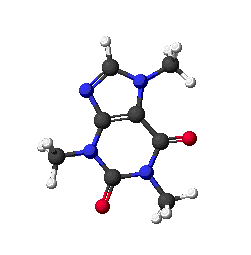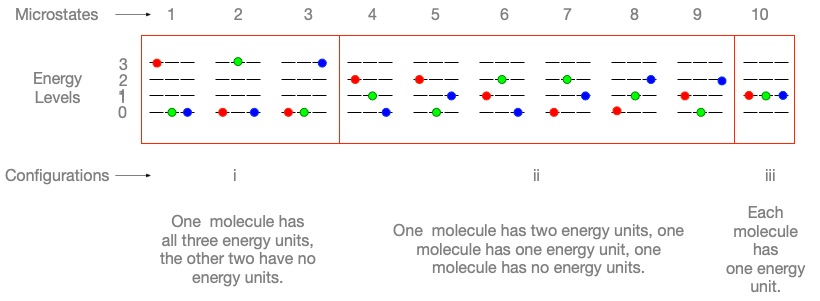
Chemistry
Chemistry 18: 1-3

WebLecture
Entropy
Outline
- Entropy and Reactions
- Spontaneity
- Practice with Concepts
- Discussion Questions
- Optional Website Reading
Entropy and Chemical Reactions
It's time to put our study of chemistry in context. We started by talking about the importance of chemistry in our daily lives, and the practicalities of studying it with the scientific method. We've looked at the basic unit of matter, the atom, and how it combines by sharing electrons with other atoms to form molecules. We saw how different kinds of chemical reactions result in the production of gas or precipitates, and how any kind of reaction involves a change in energy state. We've looked at the behavior of matter in gas, liquid, and solid states, and how this behavior depends on forces between molecules — the same electric force attraction that ties atoms together within molecules, but on a different scale.
Since our discussion of ionic solid crystalline structures, though, we've focussed on reactions in solutions: how we measure concentration, how changes in concentration or temperature affect reactions, how the progress of a reaction affects concentration. We've looked at the special case of acid and base reactions, recognizing that water can act as either, so essentially any reaction which involves the dissolution of a solute that changes the pH of the water is an acid-base reaction.
Now we turn again to look at energy considerations in more detail, and examine not only the enthalpy of reactions, but the change in entropy as well, and how these changes determine whether or not a reaction can occur.
Spontaneity
In generally, a reaction will occur, in fact, any physical process will proceed, if the end of the process results in a lower energy state than the original one. Water flows downhill: the gravitational potential energy is lower for the water at the bottom of the hill. Chemical reactions started with minimal activation energy will run without further energy input if the energy stored in the bonds of products is less than the energy stored in the bonds of the reactants.
We identified the change in energy of a system as a flow of heat energy into or out of the system, plus the work done on the environment by the system, or the work done by the system on the environment.
But it turns out heat energy and work are not the only factors that we have to consider. There are situations where a physical or chemical change is spontaneous requiring energy input. Ice melts at temperatures above 0°C. Ionic solids dissolve in water spontaneously, even when dissolution requires constant energy input. Some reactions are spontaneous in both directions in order to reach equilibrium.
Obviously, another factor must be involved.
Entropy
That factor is entropy. Entropy is sometimes defined as the amount of disorder in a system, but a more precise definition (which explains what physicists and chemists mean by disorder) involves energy directly: entropy is a measure of the distribution or dispersal of energy in a system.
Suppose that we have a system in which 100 particles share 100 units of energy. We consider the system "most ordered" if one of the particles has all of the energy, and the rest have none, and "most disordered" if each particle has one unit of energy. In the first situation, the only changes allowed would move some energy to other particles, increasing the dispersion of energy, that is, increasing the entropy of the system. One of the rules of entropy is that energy flows from higher concentrations of energy to lower concentrations of energy. We see this most clearly in heat exchange: heat flows from hotter to colder systems.
In the second situation, where energy is distributed equally among all particles, there is no heat flow. If we want to create a situation in which heat energy is again concentrated in fewer particles, we will need to do work, that is, to put energy into the system to create a higher level of order and energy concentration.
This leads us back to the fundamental laws of thermodynamics:
- Zeroth Law: Heat flows from hotter substances to colder substances. It does not flow between objects at the same temperature (in equilibrium).
- First Law: Energy of any kind cannot be created or destroyed. This is the law of the conservation of energy.
- Second Law: A spontaneous change will cause an entropy increase. Another way to put this is that any random change is more likely to increase entropy than decrease it.
- Third Law: Zero entropy (maximum order) occurs in a perfect crystal at 0°K (an impossible state to reach).
Now, the other thing to realize is that thermodynamics laws are statistical: they measure the likelihood of the behavior of a system of discrete particles. The more particles you have in a system, the more likely the system is to behave according to the laws of thermodynamics.
Suppose I have a handful of cards - the Ace, 1, 2, 3, 4, and 5 of diamonds. According to the law of combinations, there are 6 * 5 * 4 * 3 * 2 * 1 = 720 possible orders I could achieve by randomly picking up the cards. Picking them up Ace - 1 - 2 - 3 - 4 - 5 is unlikely, but not impossible. There is a 1 in 720 chance of doing exactly that. So the laws of thermodynamics indicate the most probably behavior of a system undergoing a random change, but not the specific behavior of a system for a particular change.
If we look at the situation in terms of energy, we can rank the level of order of systems by how energy is distributed among the particles in the system. Consider a system with three molecules and three units of energy to distribute among them. There are ten possible permutations for the distribution if we consider the molecules R, G, B individually:
 .
.
There are three configurations (i, ii, and iii). There is only one way for configuration iii to occur (microstate 10), so it is unusual - but not impossible. There are six ways for configuration ii to occur, and three for combination i to occur. If we start with any one of the microstates and change it randomly to one of the other states, the chance that we'll get a resulting microstate in the 4-9 range is twice as likely as the chance that we'll get a microstate in the 1-3 range.
Even distribution of energy looks to us like "order". Random possibilities like group ii look like "disorder". So the chances are that a random change in energy distribution will result in equal or greater disorder — that's the law of entropy.
The more particles and energy units we have, the more states there are that appear disordered compared to the number that appear ordered. So in most situations, there is a very high probability that after a random change, we'll find a state of greater disorder. But there is a finite, non-zero possibility that an individual change may lead to greater order.
And we can do work to force a change to result in a more ordered state.
Practice with the Concepts
Discussion Questions
- What do we actually mean by "spontaneity"? Can a reaction ever be spontaneous in both directions?
© 2005 - 2024 This course is offered through Scholars Online, a non-profit organization supporting classical Christian education through online courses. Permission to copy course content (lessons and labs) for personal study is granted to students currently or formerly enrolled in the course through Scholars Online. Reproduction for any other purpose, without the express written consent of the author, is prohibited.